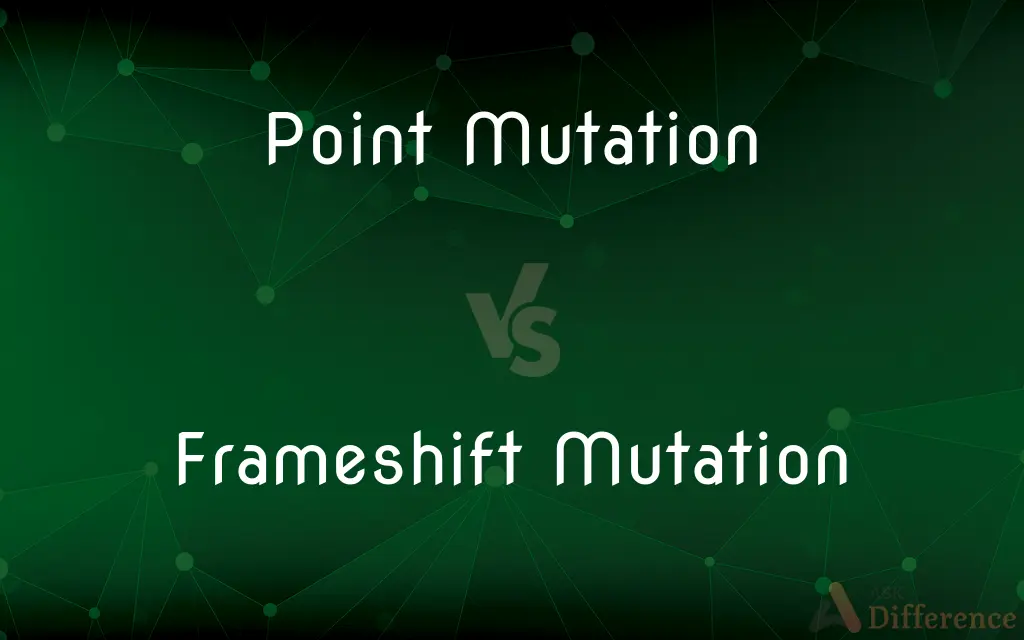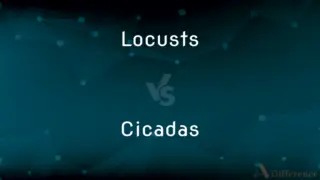Point Mutation vs. Frameshift Mutation — What's the Difference?
By Tayyaba Rehman — Published on November 2, 2023
Point Mutation involves a change in a single base pair, while Frameshift Mutation results from the insertion or deletion of base pairs, shifting the reading frame.

Difference Between Point Mutation and Frameshift Mutation
Table of Contents
ADVERTISEMENT
Key Differences
Point Mutation and Frameshift Mutation are two fundamental categories of genetic alterations, but they manifest distinctively in DNA sequences.
In a Point Mutation, there's a replacement of a single base pair in the DNA sequence. It can result in a different amino acid being incorporated during protein synthesis or might have no effect at all, depending on where it occurs. On the contrary, Frameshift Mutations happen when one or more base pairs are inserted or deleted from the DNA sequence. This insertion or deletion disrupts the regular triplet reading frame of the codons.
The consequences of these mutations vary significantly.
For a Point Mutation, the change might be benign, especially if it occurs in a non-coding region or results in the same amino acid due to the redundancy in the genetic code. However, a Frameshift Mutation almost always results in a non-functional protein, given the drastic alteration in the protein's amino acid sequence from the mutation point onward.
The cause of these mutations also differs.
ADVERTISEMENT
Point Mutations can arise due to mistakes during DNA replication or external factors like radiation. In contrast, Frameshift Mutations can result from errors in DNA replication, but they are also often caused by external factors, such as chemicals that intercalate into DNA.
While both types of mutations can have profound effects on an organism's health and fitness, the predictability of their consequences varies.
Point Mutations might or might not lead to visible changes in an organism, whereas Frameshift Mutations typically result in a more noticeable effect due to the significant alteration of the protein structure.
Comparison Chart
Definition
A single base pair change
Insertion or deletion of base pairs
Result in Protein
Might change one amino acid
Typically alters many amino acids
Causes
DNA replication errors, radiation
DNA replication errors, chemicals, intercalating agents
Occurrence
Throughout DNA
Can occur anywhere but has cascading effects
Potential Effects
Benign to harmful
Almost always harmful due to significant sequence change
Compare with Definitions
Point Mutation
A substitution at a specific location in the DNA.
A Point Mutation can lead to a different amino acid being coded for.
Frameshift Mutation
A genetic change disrupting the triplet reading frame.
A Frameshift Mutation can result in an entirely different amino acid sequence downstream.
Point Mutation
A genetic alteration at a single site.
Point Mutations can be silent, missense, or nonsense, based on their effects.
Frameshift Mutation
A significant mutation often rendering proteins non-functional.
Frameshift Mutations typically lead to diseases due to non-functional proteins.
Point Mutation
The simplest type of genetic mutation.
Even a single Point Mutation can have profound effects on protein function.
Frameshift Mutation
Insertions or deletions not in multiples of three.
A single nucleotide insertion can cause a Frameshift Mutation.
Point Mutation
A single base pair replacement in DNA.
Point Mutations might occur due to external factors like UV radiation.
Frameshift Mutation
A mutation changing the entire downstream sequence.
Frameshift Mutations drastically alter the resultant protein structure.
Point Mutation
A change involving one nucleotide pair in the DNA.
Sickle cell anemia results from a Point Mutation in the hemoglobin gene.
Frameshift Mutation
A mutation caused by the addition or removal of nucleotides.
Frameshift Mutations often lead to the creation of a premature stop codon.
Common Curiosities
Which mutation typically has more severe consequences?
Frameshift Mutations usually have more drastic effects due to the significant alteration of protein sequences.
Can Point Mutations be harmless?
Yes, some Point Mutations have no effect, especially if they result in the same amino acid or occur in non-coding regions.
How does a Frameshift Mutation affect the reading frame?
Frameshift Mutation disrupts the reading frame by inserting or deleting base pairs, leading to altered codons downstream.
Why are they called "Frameshift" Mutations?
They "shift" the reading "frame" of the codons, changing the subsequent amino acid sequence.
Do all Frameshift Mutations lead to diseases?
While not all Frameshift Mutations cause diseases, they typically lead to non-functional proteins which often result in abnormalities.
What's a silent Point Mutation?
It's a Point Mutation that doesn't change the amino acid due to the genetic code's redundancy.
Which mutation is responsible for sickle cell anemia?
Sickle cell anemia results from a Point Mutation in the hemoglobin gene.
How do Frameshift Mutations affect protein synthesis?
They can create premature stop codons or change the protein's entire amino acid sequence, often leading to non-functional proteins.
What kind of change does a Point Mutation cause?
A Point Mutation causes a change in a single base pair in the DNA.
How common are Point Mutations?
Point Mutations are relatively common and can arise from various causes, including replication errors or external agents.
Can Frameshift Mutations occur naturally?
Yes, they can arise from natural errors during DNA replication or external factors.
Are all Point Mutations harmful?
No, the effect of Point Mutations varies, and many can be neutral or even beneficial.
Can Frameshift Mutations be reversed?
It's challenging to reverse a Frameshift Mutation naturally, but certain genetic editing technologies might offer potential solutions.
Are Point Mutations always in coding regions?
No, Point Mutations can occur anywhere in the DNA, including non-coding regions.
How can Frameshift Mutations be detected?
They can be detected using DNA sequencing methods that identify insertions or deletions.
Share Your Discovery

Previous Comparison
Naphthalene vs. Anthracene
Next Comparison
Locusts vs. CicadasAuthor Spotlight
Written by
Tayyaba RehmanTayyaba Rehman is a distinguished writer, currently serving as a primary contributor to askdifference.com. As a researcher in semantics and etymology, Tayyaba's passion for the complexity of languages and their distinctions has found a perfect home on the platform. Tayyaba delves into the intricacies of language, distinguishing between commonly confused words and phrases, thereby providing clarity for readers worldwide.












































